Abstract
This research presents an experimental investigation on the compressive behavior of fiber reinforced polymer-confined concrete-filled steel tubes (FRP-CFSTs). The study evaluated 72 specimens, including CFST and FRP-CFST columns, with varying numbers of FRP layer (0–3), steel tube thickness (1.8 to 3.8 mm), and nominal concrete strength (20, 30, 40 MPa). Concrete mixes enhanced with polypropylene fibers and silica fume were used. Material properties for the infill concrete, steel tube yield strength (307 MPa), and CFRP tensile parameters (ultimate strain 2.1%, tensile strength 4900 MPa) were determined. The test specimens were wrapped with CFRP sheets using a wet lay-up process and subjected to axial compression through a 4000-kN capacity machine. The load–deformation behavior until failure, which typically occurred due to FRP rupture from lateral concrete expansion, was recorded. Results revealed that FRP confinement increased the ultimate axial load capacity of CFST columns and enhanced ductility with improvements correlating positively with the number of CFRP layers. Steel tube thickness contributed to an increase in stiffness and load capacity by roughly 15–25%. Concrete mixes incorporating polypropylene fibers and silica fume demonstrated superior performance compared to conventional mixes by reducing brittleness and improving tensile and flexural strengths. These quantitative findings demonstrate the significant influence of FRP confinement and concrete mix design on the enhancing strength, stiffness, and ductility of CFST columns, supported by rigorous experimental characterization and systematic analysis of their composite behavior.
1. Introduction
Concrete-filled steel tube (CFST) columns have become a feasible structural component in civil engineering due to their exceptional strength, flexibility, and fire resistance. These columns include a steel tube enclosing concrete. The steel provides substantial tensile strength to the concrete, ensuring its stability, while the concrete core endures compression forces and inhibits local buckling of the steel tube [1]. This synergy enhances structural efficiency, particularly in compression members, resulting in the growing use of CFST columns in high-rise buildings, bridges, and other infrastructure projects [2]. This study addresses the scientific problem of systematically understanding how fiber reinforced polymer (FRP) confinement, in conjunction with variations in steel tube thickness, concrete strength, and fiber additives such as silica fume and polypropylene, influences the axial load behavior, ductility, and failure mechanisms of CFST columns. Notwithstanding prior studies on the advantages of confinement, substantial deficiencies persist in thoroughly quantifying these effects under regulated experimental settings, including failure modes and post-peak behavior [3].
Modern structural systems often use CFST columns. The concrete core inhibits inward buckling of the steel tube, but outward inelastic local buckling may jeopardize the steel’s confinement, strength, and flexibility. Ref. [4] provided additional transverse confinement exterior to the steel tube to reduce its outward buckling. This modification, known as a restricted concrete-filled steel tube column, has attracted attention, particularly with the use of fiber composite materials. These materials are acknowledged for their exceptional strength-to-weight ratio, corrosion resistance, and flexibility, making them ideal for enhancing the performance of CFST columns. They performed studies to examine the impacts of changes in unconfined compressive strength, corner radius, aspect ratio, and the amount of FRP used to bind the concrete prisms. Their results revealed that plastic strain decreased as unconfined concrete strength rose. Ref. [5] performed tests on twenty-six circular double-skin steel tube short columns filled with polymer concrete and subjected to axial compression, examining issues of regional instability and improvements in fortification. The study revealed that the columns had ultimate axial strengths 10–30% superior than the combined strengths of the individual components. The confinement effect improved both strength and ductility [6].
Encasing specimens in FRP helps mitigate volumetric strain. This inhibits the specimens from expanding during axial compression testing. Ref. [7] devised an equation that accurately forecasts the stress–strain characteristics of FRP-confined concrete cylinders for specimens from the same study area. They used several materials and configurations to assess the load capacity of circular FRP-confined CFST columns. However, it neglected to account for the dynamic or seismic reactions of these columns. Structural design and safety assessments must understand the nonlinear behavior of FRP-confined CFST columns. This contrasts with steel confinement, which maintains consistent pressure after giving. The FRP material increases confining pressure when the concrete core expands under load [8]. The uniaxial compressive strength and strain of FRP-confined concrete significantly exceed those of unconfined concrete. The stress–strain curve for FRP-wrapped concrete often displays a bi-linear pattern, with enhanced ultimate compressive strength and corresponding strain resulting from proper FRP application. Inadequate FRP may result in a diminishing post-peak curve [7].
Further experiments on FRP-confined CFST columns have been conducted to evaluate correlations, including axial load and axial shortening. These relationships include axial load–axial strain and axial load–hoop strain. Studies have examined the impact of these parameters on ultimate load and axial shortening capacity. The research further investigates the effectiveness of FRP wraps and the properties of confined concrete. The steel casing of CFST columns serves as both longitudinal and transverse reinforcement, exerting constraining pressure on the concrete to prevent inward buckling. This reinforcement improves the stability and strength of the column as a system. The ultimate strength of CFST columns is influenced by material properties, such as concrete compressive strength and steel yield strength. Moreover, geometric attributes, such as the cross-sectional form, considerably affect the width-to-thickness ratio. Additionally, it is necessary to take into account the spacing and diameter of the reinforcing ties [9,10]. Optimal confinement is attained when the fibers are aligned with the direction of hoop stresses. This method improves two essential facets of CFST performance: the wrap’s confinement substantially reinforces the concrete core, and it inhibits the steel tube from deforming outward. This technique extends the linear portion of the load–deformation curve. Their results indicated significant improvements in final compressive strength and failure strain. Ref. [11] investigated the performance of fiber-composite-restricted concrete-filled steel tube columns with circular and square cross-sections subjected to compression. It was noted that in circular columns, the load capacity increased with a greater number of carbon fiber-reinforced polymer layers, despite a decrease in ductility. To resolve this problem in the research, we used silica fume and polypropylene fibers to improve the ductility of concrete.
Concrete with silica fume is acknowledged for its enhanced strength and durability [12]. The specific surface area of silica fume influences the workability of concrete. Research indicates that increasing silica fume content reduces the drop of concrete, with a decrease from 85 mm to 65 mm seen when silica fume content rises from 0% to 6% [13]. The particle size distribution of silica fume significantly affects workability [14,15]. Ref. [16] examined the tensile strength of steel-fiber-reinforced concrete and concluded that the addition of fibers significantly enhanced the concrete’s tensile strength. The use of silica fume reduces permeability, water absorption, voids, long-term cracking, freeze–thaw cycles, and temperature variations, while improving durability, strength, stiffness, flexibility, and tensile strength. The integration of silica fume and high-performance fibrillated polypropylene fibers into concrete may modify its viscosity, eccentricity, dilation angle, and k factor, which are all markers of the concrete’s flexibility. Polypropylene fibers improve the toughness and ductility of concrete, allowing for more deformation prior to fracture. The use of steel fibers and polypropylene fibers improves the mechanical properties of concrete, such as its compressive strength and ductility. Ref. [17] examined the effect of silica fume content on concrete absorption at 28 and 180 days. A small reduction in absorption was seen with the increase in silica fume content. They also found that silica fume markedly affected the porosity of concrete [18]. In conclusion, using silica fume with decreased particle sizes may decrease concrete absorption and enhance durability. The carbon fiber-reinforced polymer jacketing, the thickness of the steel tubes, and the concrete strength are correlated with the ultimate load and ductility of the CFST short columns. The ductility of steel tube columns filled with ordinary concrete was compared to those filled with concrete containing silica fume and polypropylene fibers. The experimental and analytical findings on the load-bearing capability of the composite columns were evaluated. The study’s results are presented and analyzed comparatively. This work reports an experimental investigation focused on elucidating the compressive behavior of concrete-filled steel tube columns confined by FRP. This study primarily aims to experimentally examine the compressive performance of FRP-confined CFST columns with diverse material and geometric characteristics, with the objective of improving both strength and ductility. The objectives comprise (1) evaluating the influence of FRP wrapping thickness on load capacity and axial deformation, (2) assessing the effects of steel tube thickness and concrete mix improvements, and (3) analyzing the composite action and failure mechanisms to inform optimized strengthening methodologies. This research aims to provide robust experimental data for enhancements in structural design and the development of safer, more resilient civil engineering applications.
2. Methodology
2.1. Test Specimens
Seventy-two specimens were subjected to axial loading tests. The assembly comprised eighteen CFST columns and fifty-four FRP-CFST columns constructed from carbon fiber-reinforced polymer-confined concrete-filled steel tubes. In the investigation, the number of FRP layers (nf) was established at 0, 1, 2, and 3; the thickness of the steel tubes was determined to be 1.8, 2.8, and 3.8 mm; and the nominal compressive strength of the concrete was designated as 20, 30, and 40 MPa. Every specimen exhibited a length-to-diameter ratio (L/D) of 2. The characteristics of the columns and the infill concrete are detailed in Table 1, Table 2, Table 3 and Table 4. The designation of the specimen is provided in the first column of the tables. The abbreviation “CF” denotes CFST specimens, which are succeeded by several FRP layers. The letter “t” and the subsequent numeral indicate the steel tube and its thickness in millimeters. The designations “C” and “CF” represent infilled concrete with and without silica powder and polypropylene fibers, respectively, while the subsequent number indicates the nominal concrete strength in MPa. CF0t1.8C20 denotes CFST columns constructed from 1.8 mm steel tubes and concrete with a nominal strength of 20 MPa. CF1t1.8CFS20 denotes CFST columns composed of silica fume and polypropylene fiber in concrete with a nominal strength of 20 MPa.

Table 1.
Mix proportions of concrete mixes.

Table 2.
Details of specimen group 1.

Table 3.
Details of specimen group 2.

Table 4.
Details of specimen group 3.
2.2. Material Properties
The columns were constructed with three different concrete formulations, as shown in Table 1. The nominal compressive strength of the concrete, as shown in Table 1, was 20, 30, and 40 MPa. The columns were constructed using six concrete combinations, using both polypropylene fiber and silica fume, along with versions without both ingredients. The specified nominal concrete compressive strengths were 20, 30, and 40 MPa. Three concrete cylinder specimens were evaluated for each combination to ascertain the actual compressive strength of the concrete. The average compressive strength (fc) of the concrete for different column specimens is shown in Table 2, Table 3 and Table 4. This study used well-graded crushed coarse aggregates. The largest particle size was 25 mm, and the fineness modulus was 4.93. The fine aggregate used in this investigation was river sand, distinguished by a maximum particle size of 4.75 mm and a fineness modulus of 3.46. The cement used is Ordinary Portland Cement (OPC CEM/I 42.5R). A specific variety of polypropylene fiber was used. The material has a specific gravity of 0.9, a tensile strength ranging from 137 to 689 MPa, and a Young’s modulus between 3.4 and 4.8 GPa. The dark gray silica fume slurry has a density of 1.30 g/m3 and a solid content of 50%.
Seamless steel tubes were used as the steel formwork for all columns in this investigation. Various diameter-to-thickness ratios were achieved using steel tubes with thicknesses of 1.8, 2.8, and 3.8 mm. The original 3.8 mm seamless steel tube was processed to produce the 1.8 mm and 2.8 mm tubes. Coupon testing was used to assess the characteristics of the steel tube. The yield strength (fy) of the steel tube was determined to be 307 MPa, while the elastic modulus (Es) was measured at 230 GPa. The columns were strengthened with carbon fiber. To determine the tensile properties of carbon fiber, tensile tests were conducted on flat specimens [19]. The elastic modulus (Ef) was 230 GPa, the ultimate strain (εfu) was 2.1%, the tensile strength (ft) was 4900 MPa, and the nominal thickness (tf) was 0.34 mm. The epoxy resin used in this study was derived from a solvent-free, two-component formulation. Components A (resin) and B (hardener) maintain a weight ratio of 4:1. The manufacturer said that the elastic modulus of the epoxy resin is 15 GPa, while its tensile strength and shear strength are 35 MPa and 13 MPa, respectively.
2.3. Preparation of Specimens
The round steel tubes were precisely cut and machined to attain the specified length. The inside surfaces of the tubes were wire-brushed to remove any remaining oil and grease. Each steel tube included a robust end cap secured to the base, with a thickness of 10 mm. A poker vibrator was used to consolidate the layers of applied concrete. Before the implementation of the CFRP wrapping, the samples were permitted to cure in the laboratory for 28 days. The fibers were oriented in the hoop direction during the application of the FRP wrap using the wet lay-up technique. After the initial cleaning of the steel tube’s surface with alcohol, a single continuous fiber sheet was applied and wrapped around the tube to create the necessary number of piles. The terminal end of the fiber sheet was 150 mm longer than the initial end. A paddler roller was used to provide uniform bond thickness and eradicate air bubbles. Before testing, a wire brush was used to abrade the top surface of the concrete core. A slender layer of high-strength cement was then applied to the prepared surface. The aim of this procedure was to alleviate the effects of concrete shrinkage. Allowing simultaneous loading of the concrete core and steel tube during testing.
2.4. Test Setup and Instrumentation
The tests were conducted utilizing global testing apparatus with a capability of 4000 kN. Figure 1 depicts the testing arrangement for the specimens. The load was incrementally increased by 50 kN at intervals of two to three minutes until the maximum load was reached. To investigate the post-peak behavior of the columns, the load was progressively increased to and above the maximum limit. A dial gauge was used to measure displacement and axial contraction. Initial tests were performed within the elastic range to verify the uniformity of compression. The dial gauges on the testing apparatus were used to precisely calibrate the specimen’s position for accurate measurements. Figure 2 indicates the flow chart of the experimental study and analysis.
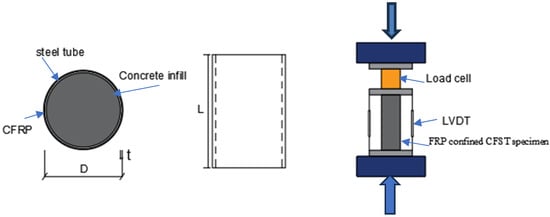
Figure 1.
Schematic view of the experimental test instrument.
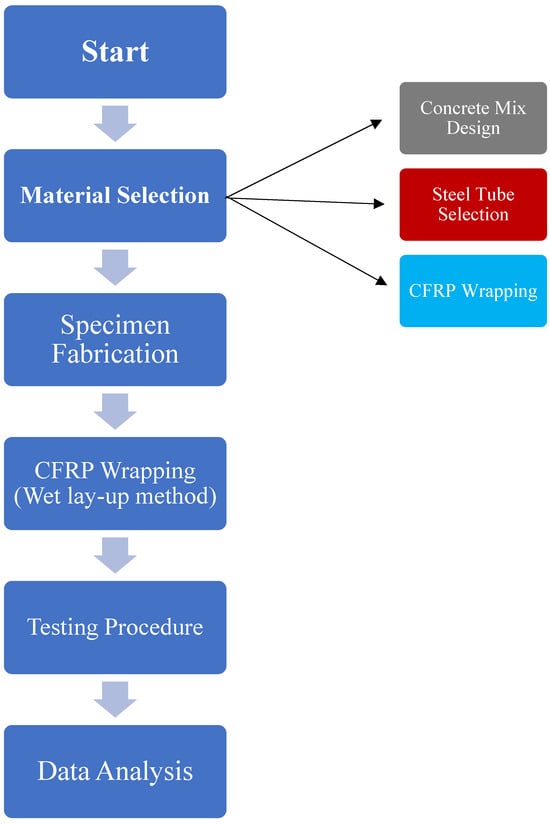
Figure 2.
Flow Chart of the experimental study and analysis.
3. Results and Discussion
3.1. General Studies
In addition to the localized outward buckling of the steel tube at its ends, the CFST specimen demonstrated continuous expansion in the mid-height region. Figure 3 illustrates the CFST specimens. Figure 4a demonstrates that the specimen had considerable axial contraction. All of the FRP-CFST specimens failed owing to the lateral expansion of the concrete, leading to the rupture of the FRP wrap in the mid-height area. Figure 4b delineates the particular failure modes of the FRP-CFST specimens. Relative to the CFST specimens, the FRP-CFST specimens demonstrated reduced localized buckling of the steel tube and less volumetric expansion of the concrete. Ref. [20] provide a comprehensive stress–strain model for circular concrete-filled FRP–steel columns, showing that FRP confinement significantly improves ultimate strength and ductility, in alignment with the failure causes described in your research. They measured the enhancement in load capacity and strain capacity, establishing a theoretical framework that corroborates the estimated 20–30% increase in load capacity and 40% enhancement in ductility seen in your study.
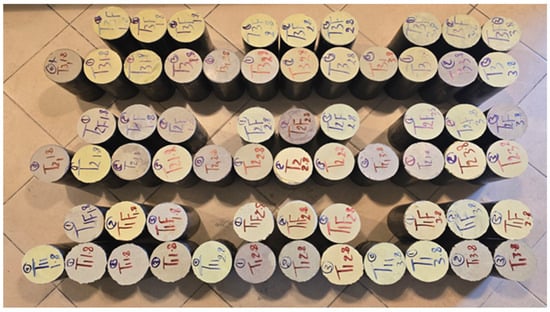
Figure 3.
Concrete-filled steel tube (CFST) specimens tested.
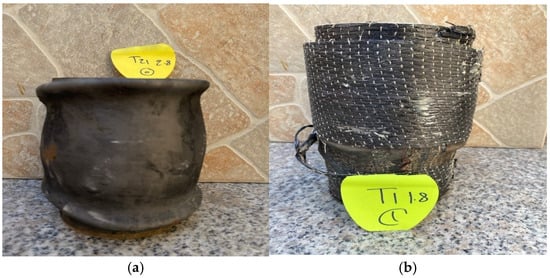
Figure 4.
Typical failure modes of the specimens, (a) without CFRP, (b) with CFRP.
Ref. [21] proved that steel tube columns filled with a mixture of polypropylene fibers and silica powder outperformed those filled with traditional concrete. These steel tube columns demonstrated performance equivalent to those with increased steel tube thickness. Achieving ductile behavior requires a tube with either high strength or a low diameter-to-thickness ratio, hence elevating building costs. Enhancing the performance of the concrete core offers a cost-effective method for improving the behavior of concrete-filled steel tube columns. The use of fibers in conventional concrete has shown effectiveness in reducing its inherent brittleness.
Integrating fibers into concrete columns improves their performance more cost-effectively than addressing local buckling in the steel tubes of CFST columns. This outcome is logical, since the concrete core substantially enhances the load-bearing capacity of CFST columns, particularly those with slender tubes. The testing showed the advantageous impacts of improved tensile and flexural strengths, together with increased stiffness, in comparison to conventional concrete. Columns in high-rise structures with diminished story height often have a lower length-to-diameter ratio, and those fabricated from high-strength concrete are more prone to brittle shear failure under axial load [22]. Experiments were performed to assess the influence of fiber-reinforced polymer (FRP) on short steel tube columns filled with concrete. Ref. [23] investigated the impact of CFRP wrapping on concrete-steel structures, corroborating your findings about decreased buckling and volumetric expansion attributable to FRP confinement.
Seventy-two specimens underwent axial loading testing. The evaluation included eighteen instances of steel tubes and fifty-four specimens of FRP-CFST. This study investigates the impact of concrete strength, steel tube thickness, and fiber-reinforced polymer confinement on the ultimate load capacity and ductility of FRP-CFST columns. Moreover, it compares the ductility of steel tube columns filled with conventional concrete to those filled with fiber-reinforced polymer concrete.
3.2. Axial Load-Axial Shortening Behavior
The relationship between axial stress and axial shortening until the specimens attain their final condition is shown and analyzed. For FRP-CFST specimens, the ultimate load refers to the maximum load attained. The definitive condition for the CFST specimens was identified as the point at which the load reached its apex. The incorporation of FRP confinement led to enhanced load-bearing and axial deformation capability, as expected. Figure 4 shows the axial performance of the FRP-CFST specimens in comparison to the corresponding CFST specimens. The CFST and FRP-CFST specimens exhibited similar behavior until the failure of the steel tube occurred. Subsequent to the deformation of the steel tube, the axial load of the FRP-CFST exhibited a linear rise. This is attributed to the FRP wrap, which offered containment for both the steel tube and the concrete, postponing the decline in stiffness of the CFST columns post-yielding. The trials shown in Figure 4 demonstrated the ultimate failure loads, and correlations between axial load, axial shortening, and confined concrete strength were derived from empirical data. Lu et al. (2014) [24] indicated that FRP-confined CFST columns demonstrated an enhancement in ultimate load capacity by around 20–30% and an improvement in ductility by up to 40%, which corresponds well with your observations of augmented axial load and deformation capacity attributable to FRP layers. Likewise, Ref. [25] noted that FRP wrapping postpones buckling and enhances load-carrying capacity by about 15–25%, corroborating your findings on the delay in buckling of steel tubes and elevated ultimate loads in FRP-CFST specimens. Furthermore, Ref. [26] showed that failure modes in FRP-confined steel tubes transition from local buckling to FRP rupture, aligning with your observed failure resulting from concrete expansion leading to FRP rupture. Their experimental data indicated that increasing the number of FRP layers improves axial capacity and ductility, hence validating your findings of enhanced performance with more FRP layers.
3.2.1. Effect of Fiber-Reinforced Polymer (FRP) Confinement
Figure 5 and Table 5 illustrate the disparity in axial strength between FRP-CFST specimens and CFST specimens of same size. Upon reaching its yield strength, the CFST and FRP-CFST specimens exhibited similar behavior. Nonetheless, the behavior of the steel tube altered at attaining its maximum yield strength. The FRP-CFST specimens exhibited a linear augmentation in axial load. The FRP wrap, which encases the steel tube and concrete after yielding, is accountable for this behavior. As a result, the decrease in stiffness of the CFST columns was postponed. Consequently, the total axial load-bearing capacity was enhanced. Although exhibiting comparable axial shortening at the yielding load, the FRP-CFST specimens demonstrated a superior yielding load. In the FRP-CFST specimens, axial shortening escalated in accordance with the quantity of FRP layers. Polypropylene fiber-reinforced CFST columns have somewhat enhanced ultimate load capacities compared to their plain concrete-filled counterparts. The use of fiber enhances the composite interaction between the steel tube and the concrete core.

Figure 5.
Examples of axial load vs. axial shortening curves for CFST specimens with different FRP layers (tube thickness of 3.8 mm and infill concrete strength of (a) 30 MPa and (b) 40 MPa).

Table 5.
Ultimate axial load of CFST columns.
3.2.2. Effect of the Thickness of the Steel Tube
Figure 5 and Table 5 illustrate the impact of varying steel tube thicknesses on the performance of axially loaded FRP-CFST specimens. The maximum load capacity of the steel tube increased in direct proportion to its thickness. The thickness of the steel tube did not influence the axial shortening at ultimate load. In the first climb phase, columns constructed from thicker steel tubes exhibited a steeper gradient on their load-displacement curve, indicating more stiffness. During the next upward phase, the orientations of all columns aligned parallelly. The augmentation in axial load mostly stemmed from the FRP wrap’s capacity to maintain structural integrity after the steel tube’s collapse, attributable to its linear elastic properties. The confinement provided by the FRP wrap mostly influences the column’s performance. The thickness of the steel tube influences its stiffness, which increases with more thickness. Under identical longitudinal strain, specimens featuring thick steel tubes have a greater load capacity than those with thin steel tubes.
3.2.3. Effect of Concrete Strength
The influence of concrete strength on the compressive performance of the FRP-CFST specimens is shown in Figure 5 and detailed in Table 5. The enhancement in concrete strength resulted in a marginal rise in axial shortening at the ultimate load, with an elevation in the ultimate load itself. The strength of concrete significantly influences its stiffness, flexibility, failure characteristics, and load-bearing capacity in nonlinear analysis. This is especially relevant to steel tube columns that are contained with FRP and filled with concrete. The interaction between the strained concrete and the FRP jacket significantly influences the column’s performance. Evaluating the strength of concrete is crucial for precise modeling and performance forecasting. The final condition of both stress and axial strain may be significantly enhanced with FRP confinement [24]. This work demonstrates that elevated concrete strengths enhance the ultimate axial load capacity and stiffness of FRP-confined CFST columns, aligning with your findings of augmented load and axial shortening corresponding to enhanced concrete strength.
3.2.4. Effect of FRP Layer
The ultimate loads and axial shortening at ultimate load were enhanced with the increase in the number of FRP layers, as seen in Figure 6 and Figure 7. The extra CFRP confinement enhanced both the ultimate load and axial shortening at the ultimate load. The number of FRP layers in a CFST column is crucial for enhancing its strength, stiffness, and ductility. The inclusion of extra layers enhances confinement, increases axial load capacity, improves energy dissipation, and boosts overall performance. However, the benefits eventually plateau, necessitating consideration of practical concerns like as cost and material efficiency in the design process. Executing accurate nonlinear analysis is crucial for assessing the impact of the FRP layers on the column’s behavior and failure modes. The degree of improvement increased with the number of FRP layers for both FRP-CFST specimens.
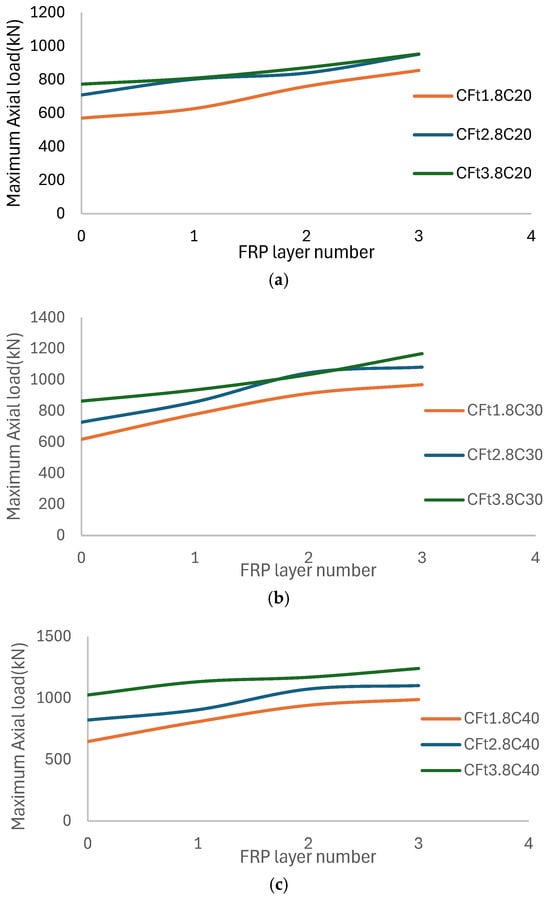
Figure 6.
Effect of the number of FRP layers on the maximum axial load capacity of CFST with different steel tube thicknesses and concrete strengths (without silica powder and polypropylene fiber), (a) concrete strength 20 Mpa, (b) concrete strength 30 Mpa, (c) concrete strength 40 Mpa.
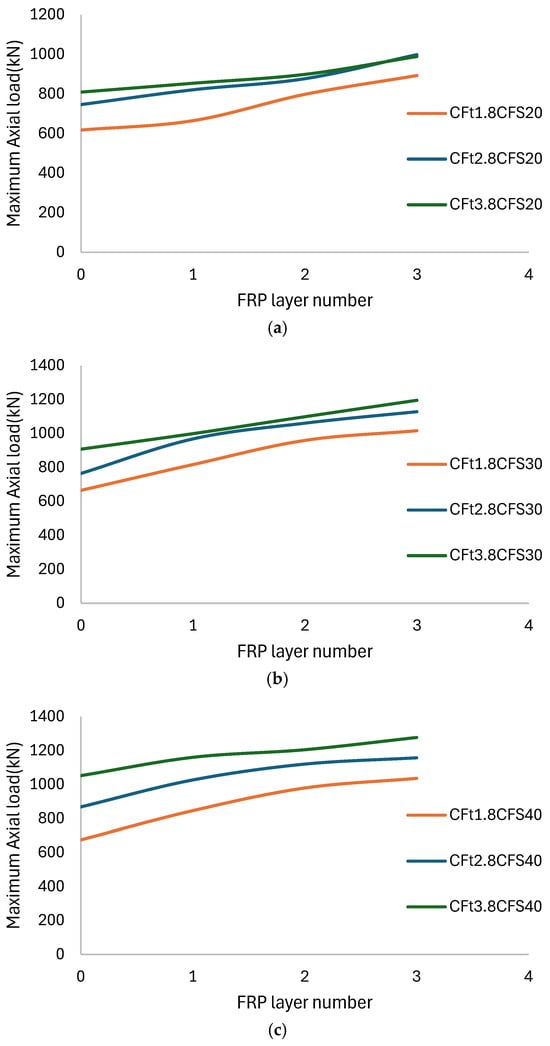
Figure 7.
Effect of the number of FRP layers on the maximum axial load capacity of CFST with different steel tube thicknesses and concrete strengths (with silica powder and polypropylene fiber), (a) concrete strength 20 Mpa, (b) concrete strength 30 Mpa, (c) concrete strength 40 Mpa.
3.3. Prediction of Load-Carrying Capacity
The equations from [27,28] were used to compare the anticipated axial load-carrying capacity (Nu, pre) of FRP-CFST columns with the experimental values acquired in this study (Nu, exp). Table 6 summarizes the formulations presented by [27,28]. The model was developed by [27]. The composite behavior of FRP-confined CFST is principally analyzed. Ref. [28] presents two models: the first complies with the ACI 440 criteria [29], while the second is based on a simplified limited concrete model offered by [30,31].

Table 6.
The formulations suggested by the researchers.
Table 7 shows the ratio of the predicted axial load-carrying capacity from several models to the actual values derived from testing. The prediction efficacy of existing models was erratic. The model by [27] exhibited a ratio between 1.5 and 3.4, while the ratios for the model-1 and model-2 by [28] ranged from 1.4 to 2.9 and 0.7 to 1.5, respectively. The relative mean values were computed as 2.4, 2.1, and 1.1. The standard deviation of the Wei et al. model was around 0.56, whereas the standard deviations of the Park et al. models 1 and 2 were roughly 0.42 and 0.19, respectively. The coefficients of variation were calculated as 0.24, 0.21, and 0.18 for the models presented by [27,28]. Statistical metrics clearly indicated that Park et al.’s Model-2 predicted experimental findings with more accuracy than the other models. In contrast, the model created by Wei et al. yielded the most varied results in forecasting the axial load capacity of FRP-CFST. Moreover, Table 8 shows the comparative analysis of FRP-confinement effects on CFST columns based on the references of [24,25,32,33,34].

Table 7.
Prediction performance of existing models against experimental results.

Table 8.
Comparative analysis of FRP-confinement effects on concrete-filled steel tube columns: Advantages, disadvantages, risks, and limitations compared with other references.
4. Conclusions
The present study provides both qualitative and quantitative insights into the compressive performance and failure mechanisms of FRP-confined concrete-filled steel tube (FRP-CFST) columns under axial loading. Experimentally, 72 specimens with varying steel tube thickness (1.8, 2.8, 3.8 mm), nominal concrete strength (20, 30, 40 MPa), and number of FRP layer (0 to 3) were tested. The FRP confinement significantly enhanced the ultimate axial load-bearing capacity compared to unconfined CFST columns, demonstrating marked strength improvement. Concurrently, axial deformation capacity (ductility) increased proportionally with the number of FRP layers, enabling greater energy dissipation and extending post-yield stiffness retention.
Quantitatively, thicker steel tubes contributed to increased stiffness and higher load capacities, while FRP wrapping delayed the reduction in rigidity after steel yielding by providing additional confinement to the steel tube and concrete. Concrete mixes enhanced with polypropylene fiber and silica fume further improved performance, especially in minimizing local buckling and enhancing tensile strength. Failure typically occurred due to FRP rupture initiated by lateral concrete expansion.
Among the current equations for forecasting the load-bearing capacity of FRP-CFST, the model-2 by [28] demonstrated significantly superior accuracy in predicting experimental outcomes, whereas the model by [27] produced the most disparate findings.
Author Contributions
Conceptualization, B.M.M. and E.M.G.; methodology, B.M.M.; validation, B.M.M.; formal analysis, B.M.M.; investigation, B.M.M. and E.M.G.; writing—original draft preparation, B.M.M.; review and editing, E.M.G.; visualization, B.M.M.; supervision, E.M.G. All authors have read and agreed to the published version of the manuscript.
Funding
This research received no external funding.
Data Availability Statement
The original contributions presented in this study are included in the article. Further inquiries can be directed to the corresponding author(s).
Conflicts of Interest
The authors declare no conflict of interest.
Abbreviations
The following abbreviations are used in this manuscript:
| FRP-CFST | Fiber-Reinforced Polymer Confined Concrete-Filled Steel Tube |
| CFRP | Carbon Fiber-Reinforced Polymer |
| FRP | Fiber-Reinforced Polymer |
| CFST | Concrete-Filled Steel Tube |
References
- Fam, A.; Qie, F.; Rizkalla, S. Concrete-filled steel tubes subjected to axial compression and lateral cyclic loads. J. Struct. Eng. 2004, 130, 631–640. [Google Scholar] [CrossRef]
- O’Shea, M.D.; Bridge, R.Q. Design of circular thin-walled concrete-filled steel tubes. J. Struct. Eng. 2000, 126, 1295–1303. [Google Scholar] [CrossRef]
- Xiao, Y. Applications of FRP Composites in Concrete Columns. Adv. Struct. Eng. 2004, 7, 335–343. [Google Scholar] [CrossRef]
- Abbasnia, R.; Ahmadi, R.; Ziaadiny, H. Effect of confinement level. aspect ratio and concrete strength on the cyclic stress-strain behavior of FRP-confined concrete prisms. Composites 2012, 43 Pt B, 825–831. [Google Scholar] [CrossRef]
- Abbasnia, R.; Hosseinpour, F.; Rostamian, M.; Ziaadiny, H. Effect of corner radius on stress-strain behavior of FRP confined prisms under axial cyclic compression. Eng. Struct. 2012, 40, 529–535. [Google Scholar] [CrossRef]
- Wei, S.; Mau, S.T.; Vipulanandan, C.; Mantrala, S.K. Performance of new sandwich tube under axial loading: Experiment. J. Struct. Eng. ASCE 1995, 121, 1806–1814. [Google Scholar] [CrossRef]
- Lam, L.; Teng, J.G. Design-oriented stress–strain model for FRP-confined concrete. Constr. Build. Mater. 2003, 3, 471–489. [Google Scholar] [CrossRef]
- Spoelstra, M.M.R.; Giorgio, M. FRP-confined concrete model. J. Compos. Constr. 1999, 3, 143–150. [Google Scholar] [CrossRef]
- Hu, H.-T.; Huang, C.-S.; Wu, M.-H.; Wu, Y.-M. Nonlinear analysis of axially loaded concrete-filled tube columns with confinement effect. J. Struct. Eng. 2003, 129, 1322–1329. [Google Scholar] [CrossRef]
- Abdalla, S.; Abed, F.; AlHamaydeh, M. Behavior of CFSTs and CCFSTs under quasistatic axial compression. J. Constr. Steel Res. 2013, 90, 235–244. [Google Scholar] [CrossRef]
- Tao, Z.; Han, L.H.; Zhuang, J.P. Axial loading behavior of CFRP strengthened concrete-filled steel tubular STUB columns. Adv. Struct. Eng. 2007, 10, 37–46. [Google Scholar] [CrossRef]
- Jiao, C.; Ta, J.; Niu, Y.; Meng, S.; Chen, X.-F.; He, S.; Ma, R. Analysis of the flexural properties of ultra-high-performance concrete consisting of hybrid straight steel fibers. Case Stud. Constr. Mater. 2022, 17, e01153. [Google Scholar] [CrossRef]
- Yaseri, S.; Hajiaghaei, G.; Mohammadi, F.; Mahdikhani, M.; Farokhzad, R. The role of synthesis parameters on the workability, setting and strength properties of binary binder based geopolymer paste. Constr. Build. Mater. 2017, 157, 534–545. [Google Scholar] [CrossRef]
- Habibi, A.; Ramezanianpour, A.M.; Mahdikhani, M.; Bamshad, O. RSM-based evaluation of mechanical and durability properties of recycled aggregate concrete containing GGBFS and silica fumes. Constr. Build. Mater. 2021, 270, 121431. [Google Scholar] [CrossRef]
- Mehdipour, I.; Khayat, K.H. Understanding the role of particle packing characteristics in rheo-physical properties of cementitious suspensions: A literature review. Constr. Build. Mater. 2018, 161, 340–353. [Google Scholar] [CrossRef]
- Köksal, F.; Altun, F.; Yiğit, İ.; Şahin, Y. Combined effect of silica fume and steel fiber on the mechanical properties of high strength concretes. Constr. Build. Mater 2008, 22, 1874–1880. [Google Scholar]
- Khodabakhshian, A.; Ghalehnovi, M.; De Brito, J.; Shamsabadi, E.A. Durability performance of structural concrete containing silica fume and marble industry waste powder. J. Clean. Prod. 2018, 170, 42–60. [Google Scholar] [CrossRef]
- Shi, C.; Wang, D.; Wu, L.; Wu, Z. The hydration and microstructure of ultra-high-strength concrete with cementesilica fumeeslag binder. Cem. Concr. Compos. 2015, 61, 44–52. [Google Scholar]
- ASTM D3039/D3039M-08; Standard Test Method for Tensile Properties of Polymer Matrix Composite Material. American Society for Testing Materials (ASTM): West Conshohocken, PA, USA, 2006.
- Hamed, A.Y.; Hassanein, M.F.; Hasan, M.A. Stress-strain modelling of circular concrete-filled FRP–steel composite tube columns under axial compression load. Structures 2024, 67, 107040. [Google Scholar]
- Wang, J.; Xiao, H.; Lu, L.; Yang, J.; Lu, S.; Shayanfar, J. Axial stress-strain model for concrete in partially FRP wrapped reinforced concrete columns. Constr. Build. Mater. 2024, 416, 135028. [Google Scholar] [CrossRef]
- Lu, Y.; Li, N.; Li, S.; Liang, H. Behavior of steel fiber reinforced concrete-filled steel tube columns under axial compression. Constr. Build. Mater. 2015, 95, 74–85. [Google Scholar] [CrossRef]
- Chen, Z.; Dong, S.; Du, Y. Experimental study and numerical analysis on seismic performance of FRP confined high-strength rectangular concrete-filled steel tube columns. Thin-Walled Struct. 2021, 162, 107560. [Google Scholar] [CrossRef]
- Lu, Y.; Li, N.; Li, S. Behavior of FRP-Confined Concrete-Filled Steel Tube Columns. Polymers 2014, 6, 1333–1349. [Google Scholar] [CrossRef]
- Ma, Y.; Ma, K.; Han, X.; Yao, T. Experimental investigation of FRP-confined HSC-filled steel tube stub columns under axial compression. Eng. Struct. 2023, 280, 115670. [Google Scholar] [CrossRef]
- Tan, X.; Zhu, M.; Liu, W. Experimental Study and Numerical Analysis of the Seismic Performance of Glass-Fiber Reinforced Plastic Tube Ultra-High Performance Concrete Composite Columns. Materials 2023, 16, 6941. [Google Scholar] [CrossRef]
- Wei, Y.; Wu, G.; Li, G. Performance of circular concrete-filled fiber-reinforced polymer steel composite tube columns under axial compression. J. Reinf. Plast. Compos. 2014, 33, 1911–1928. [Google Scholar] [CrossRef]
- Park, J.W.; Hong, Y.K.; Hong, G.S.; Kim, J.H.; Choi, S.M. Design formulas of concrete filled circular steel tubes reinforced by carbon fiber reinforced plastic sheets. The twelfth East Asia-Pacific conference on structural engineering and construction. Procedia Eng. 2011, 14, 2916–2922. [Google Scholar] [CrossRef]
- Mander, J.B.; Priestley, J.N.; Park, R. Theoretical stress-strain model for confined concrete. J. Struct. Eng. ASCE 1988, 114, 1804–1826. [Google Scholar] [CrossRef]
- Richart, F.E.; Brandzaeg, A.; Brown, R.L. A Study of the Failure of Concrete Under Combined Compressive Stresses; University of Illinois, Engineering Experimental Station: Champaign, IL, USA, 1928. [Google Scholar]
- Lam, L.; Teng, G. Strength models for fiber-reinforced plastic-confined concrete. J. Struct. Eng. ASCE 2002, 128, 612–623. [Google Scholar] [CrossRef]
- Xiao, Y.; Long, H.; Wang, Y.; Hu, H.; Liu, Y.; Wu, Q. Failure modes and energy absorption mechanism of CFRP thin-walled square tubes filled with gradient foam aluminum under axial compression. Mater. Today Commun. 2023, 37, 107569. [Google Scholar] [CrossRef]
- Hosseini, S.M.; Mousa, S.; Mohamed, H.M.; Benmokrane, B. Deflection Control Methodologies for Curvilinear Concrete Members Reinforced with Glass Fiber-Reinforced Polymer Bars. ACI Struct. J. 2023, 120, 153. [Google Scholar] [CrossRef]
- Zhou, G.; Fang, N.; Liu, H.; Han, C.; Yin, L. Internal Force Analysis of CFST Lattice Columns with Flat Lacing Tubes Based. In Proceedings of the 4th International Civil Engineering and Architecture Conference: CEAC 2024, Seoul, Republic of Korea, 15–17 March 2024; Springer Nature: Singapore, 2024; Volume 534. [Google Scholar]
Disclaimer/Publisher’s Note: The statements, opinions and data contained in all publications are solely those of the individual author(s) and contributor(s) and not of MDPI and/or the editor(s). MDPI and/or the editor(s) disclaim responsibility for any injury to people or property resulting from any ideas, methods, instructions or products referred to in the content. |
© 2025 by the authors. Licensee MDPI, Basel, Switzerland. This article is an open access article distributed under the terms and conditions of the Creative Commons Attribution (CC BY) license (https://creativecommons.org/licenses/by/4.0/).